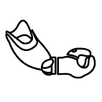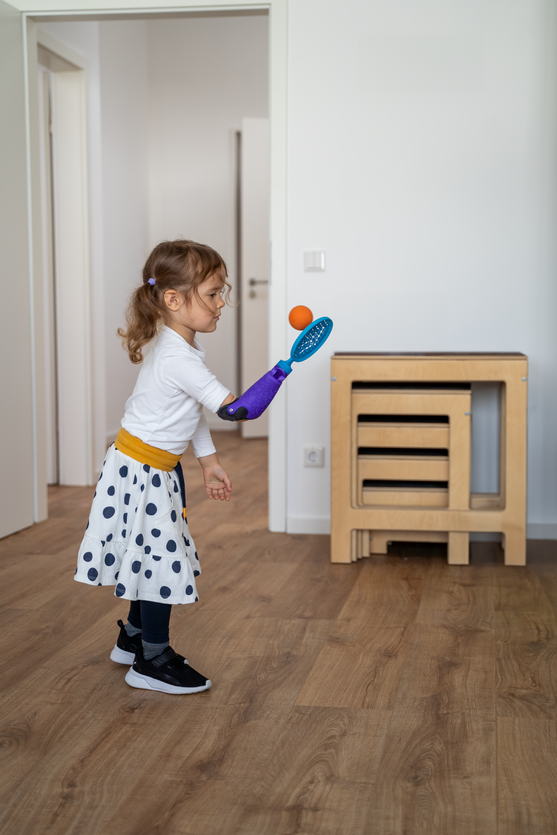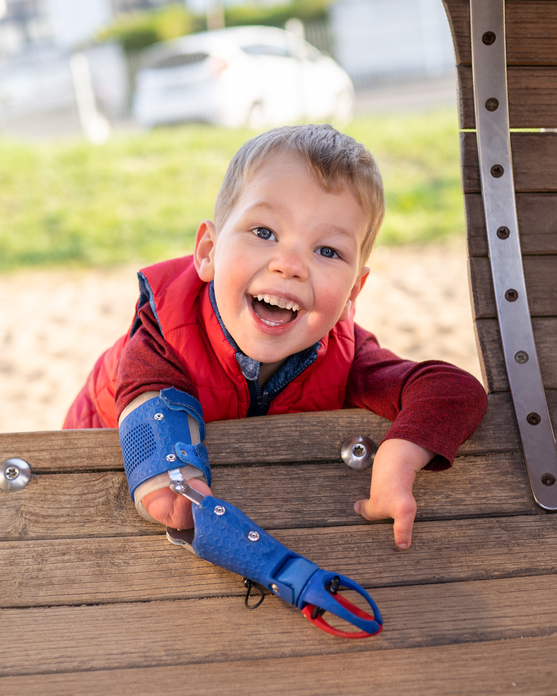
The FIRST prosthesis is an arm prosthesis for small children and has various interchangeable attachments.
Was your child born without a hand? Let us clarify what treatment options you have.
Make an appointment over the phone or send us a message!

Does a prosthetic arm make sense for my child?
For parents who are expecting, the diagnosis of dysmelia can come as a shock. Learning that your child will be born without a hand or arm can lead to many questions and you may find yourself wondering whether your child will be able to live their life confidently and independently. Understandably, this situation can be quite overwhelming. Parents of children that lose their hand or arm in an accident may have similar questions. Additionally, they may also be faced with the difficult decision of whether an arm prosthesis is the right solution for their child, and if yes, what age would be the most appropriate to get started.
We will be there for you during these challenging times and consult you on your options for prosthetic treatment. A prosthesis should offer more advantages than disadvantages for your child. As such, we make sure to take into account your child’s individual requirements.
What options exist for my child?
Early prosthetic treatment

Unlike people who undergo amputation in adolescence or adulthood, children born with dysmelia do not perceive anything to be missing from their body image. With their two differently formed hands, they feel like a whole person with an intact body schema. Often, these children develop amazing dexterity and sensitivity in their malformed hands or arms. The wish for a second hand is usually expressed only when the children realize that they have disadvantages due to their malformation or that they cannot perform everyday activities as easily as their peers.
The idea of a prosthesis that helps children learn to use both hands functionally at an early stage freqently came up during discussions with physicians, therapists, and parents. Many parents also expressed wishing that their child could get accustomed to a prosthesis as early as possible in order to prevent acceptance issues later on in life.
In the past, passive arm prostheses were offered from the age of 12 months. However, these passive aids had little functional use except for length compensation and support when holding objects. For this reason, many infants rejected this type of prosthesis.
In order to provide real benefits to children with dysmelia, we decided to focus on everyday aids. These aids are functional tools that are adapted to the developmental stage of the child. In addition, they enable a variety of everyday functions, such as eating, making music or painting. We can build basically anything to fit your child’s individual needs - from violin aids to swimming aids to basketball aids.

Between the ages of four and six, we offer children with dysmelia or amputation the option of being fitted with a myoelectric arm prosthesis. Because the electronic hand is controlled via the muscles, this type of prosthesis presents children with new challenges. In addition, children are unaccustomed to the higher weight of the prosthesis. The coordination and control of the prosthesis must be learned and continuously trained over a longer period of time.
To address the need for early prosthetic training, we developed a prosthesis system to prepare children for a fitting with a myoelectric prosthesis: the FIRST prosthesis. The letters "FIRST" stand for:
First
Integrative
Rehabilitative and
Situational
Training Prosthesis.
The FIRST prosthesis is intended to prepare children with amputations or malformations of the hand and arm for later, more complex prosthetic solutions.
New prosthetic system for infants
Grasp the world with the FIRST prosthesis
For decades, we have successfully treated children and adolescents with congenital finger, hand and arm malformations as well as traumatic hand or arm loss (amputation). We have been paying close attention to early childhood care for some time. As experts in the field of arm prosthetics, we see it as our task to investigate the advantages and disadvantages of early arm prosthesis fitting in young children and to closely accompany their acclimation to a new prosthesis. Based on many insights gained over the years, our team, consisting of experienced orthopaedic technicians and physiotherapists, has succeeded in developing a prosthesis system that can be used from infancy onwards. Numerous satisfied parents have reported that the FIRST prosthesis provides excellent support in the daily life of their toddler.
Children want to play, frolic and move. They want to craft, build and literally grasp the world. With the FIRST prosthesis, we want to enable children with arm deformities or arm amputations to participate in everyday life appropriate for children, relieve their fears and offer them the opportunity to discover the world with both hands. In short: We want to offer children the best possible support to successfully shape their future.


Depending on cognitive development, an initial fitting with the FIRST prosthesis is suitable from the age of 14 months. The innovative system, which adapts to the individual needs of the child at different ages, consists of various components that we put together according to the child's requirements. The result is an arm prosthesis that is easy for children to handle, suitable for everyday use and, above all, easily adaptable to many situations with its various attachments.

3-year-old Karlos has transverse dysmelia affecting both of his arms. With his FIRST prosthesis, he can grip many things better - for example, a crayon or fishing rod. This makes playing even more fun!
Therapy goals
Why is a prosthesis necessary in infancy?
Being able to explore and understand the world as independently as possible from the very beginning is important for the child's development and health. The following are also reasons why early prosthetic fitting may be beneficial for infants:
- Performing activities with both hands promotes healthy motor and mental development.
- Early prosthetic fitting can have a positive effect on strength, mobility and body symmetry:
- The prosthesis compensates for previous length discrepancy between the arms
- The prosthetic hand contributes to a balanced body image and can be better integrated into the child's body schema
- Development of hand-hand, hand-eye, and hand-mouth coordination is encouraged
- Some compensatory movements can be reduced
- Through early fitting, the child becomes playfully accustomed to wearing and functioning with an arm prosthesis
- The child's dexterity is trained through playful handling of the prosthesis
- The aim of the prosthesis fitting is to counteract possible overloading, which can be caused by overstraining the unaffected side
- The FIRST prosthesis is intended to pave the way for permanent prosthesis use


Let yourself be inspired! We follow many interesting patients during their Pohlig appointment and give you personal insights.

For those who want to delve even deeper into the subject, we have a suitable video for almost every area of treatment!

Take a look behind the scenes at Pohlig and learn about different health conditions and our innovative assistive technology solutions!
We have developed the FIRST prosthesis, an arm prosthesis system specially made for small children, with the greatest care. It consists of a socket individually adapted to the arm (residual limb), which ensures a comfortable fit, and various attachments that can be quickly and easily replaced depending on the everyday situation.
The socket plays a central role, as it acts as a direct link between the child and the prosthesis. To make wearing the prosthesis as comfortable as possible, we manufacture the inner socket from a flexible, skin-friendly material (thermoplastic or silicone). The inner socket has very good adhesive properties and is comfortable to wear on the skin. Both the 3D-printed outer socket and the inner socket are also easy to clean.
A universal adaptation system with bayonet lock technology is integrated into the end of the socket. This system can accommodate various functional units such as a prosthetic hand, gripper, shovel, hammer, roller, cutlery adapter, etc. The socket can also be used as a tool in the sandbox, for playgrounds, for playground equipment, etc. Whether in the sandbox, painting, crafting or eating, the toddler can freely explore his environment thanks to a variety of attachments.


The FIRST prosthesis can be designed according to the child's own wishes and playfully expanded by various functional units according to age. It is important to us that the child can easily change the "tools" with a simple turn and click.
With the FIRST prosthesis, we offer a highly functional aid for small children that is visually designed to suit children. A large selection of colours and decorations promotes acceptance of the prosthesis and makes children want to use it in everyday life. In order to make the prosthesis as comfortable to wear as possible and to achieve a low weight, most of the components of the arm prosthesis are manufactured in the 3D printer.
Practice makes perfect
5 training phases with the FIRST prosthesis
Training with the FIRST Prosthesis can be divided into five phases:
First and foremost, the child has to get used to their new situation. Both the weight and the length of the arm change due to the prosthesis. The wearing time should be increased slowly to allow the child to gradually get used to the new prosthesis. Stay in contact with your child's therapist and collaborate on the next steps together.
As soon as the child has become accustomed to his new prosthesis, the discovery phase begins. The child tries to use the different tools independently and understands what he can achieve with his aid. The therapist supports the child in consciously controlling ambidextrous movements and in using the prosthetic hand in a targeted manner.
While playing, the child learns to gain more and more control over his prosthetic arm. As soon as the child notices the new possibilities opened up by the prosthesis, acceptance and motivation increase. The goal is for both hands - the natural and the prosthetic hand - to support each other optimally during play.
Tip: The child should use his prosthetic hand mainly as a "supporting hand". The healthy hand is mainly used for grasping while the the prosthetic hand is used for holding objects.
The increased use of the prosthesis makes the child's range of motion more automatic and the prosthesis becomes integrated into the body image. The child accepts his prosthesis and uses it in everyday life without thinking about it. A sign that the child has successfully integrated his prosthesis into his body schema is, for example, when he uses both hands centrally in front of the body when playing.
Once the child has become accustomed to his FIRST prosthesis, the weight of the prosthesis can be increased - depending on the residual limb length. This procedure is intended to facilitate the transition to a myoelectric prosthesis.
We will give you an overview of the typical procedure of a prosthetic fitting at POHLIG.
On our YouTube channel you will find many exciting stories about patients with prosthetic arms.
Find out why we are experts in the field for finger, hand, and arm prosthetics!



